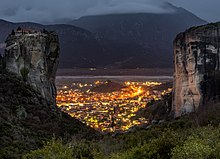| Meteora | |
|---|---|
| Native name Μετέωρα (Greek) | |
 Landscape of Meteora | |
| Location | Trikala, Thessaly, Greece |
| Coordinates | 39°42′51″N 21°37′52″E / 39.71417°N 21.63111°E |
| Area | Thessaly |
| Official name | Meteora |
| Type | Cultural |
| Criteria | i, ii, iv, v, vii |
| Designated | 1988 (12th session) |
| Reference no. | 455 |
| Region | Europe |

The Meteora (/ˌmɛtiˈɔːrə/;[1] Greek: Μετέωρα, pronounced [meˈteora]) is a rock formation in the regional unit of Trikala, in Thessaly, in northwestern Greece, hosting one of the most prominent complexes of Eastern Orthodox monasteries, viewed locally as second in importance only to Mount Athos.[2] Twenty-four monasteries were established atop the giant natural pillars and hill-like rounded boulders that dominate the local area, mainly from the second half of the 14th century under the local rule of Simeon Uroš.[3][4]: 414-415 Six of these are still active and open to visitors: the monasteries of Great Meteoron (est. 1356), Varlaam, Saint Nicholas Anapausas, Rousanou, Holy Trinity, and Saint Stephen. The latter became a community of nuns in 1961, whereas the former five remain managed by monks.
Meteora is located in between the town of Kalabaka and the village of Kastraki at the northwestern edge of the Plain of Thessaly near the Pineios river and Pindus Mountains.[5] The Meteora complex was added to the UNESCO World Heritage List in 1988 because of its outstanding architecture and beauty, combined with religious and cultural significance.[6]
The name means "lofty", "elevated", and is etymologically related to meteor.[7]
- ^ "Meteora". Oxford Living Dictionaries. Archived from the original on 29 August 2017.
- ^ Sofianos, D.Z.: "Metéora". Holy Monastery of Great Meteoro, 1991.
- ^ Cite error: The named reference
Radiocarbonwas invoked but never defined (see the help page). - ^ Cite error: The named reference
Savvideswas invoked but never defined (see the help page). - ^ Nicol, Donald MacGillivray. Meteora : The Rock Monasteries of Thessaly by Donald M Nicol. Chapman and Hall, 1963. EBSCOhost, search-ebscohost-com.holycross.idm.oclc.org/login.aspx?direct=true&db=cat06787a&AN=chc.b1193287&site=eds-live&scope=site. p. 1-2
- ^ "Meteora". Unesco World Heritage Centre. Retrieved 29 October 2022.
- ^ Henry Holland (7 June 2012). Travels in the Ionian Isles, Albania, Thessaly, Macedonia, Etc.: During the Years 1812 and 1813. Cambridge University Press. pp. 241–. ISBN 978-1-108-05044-9.
